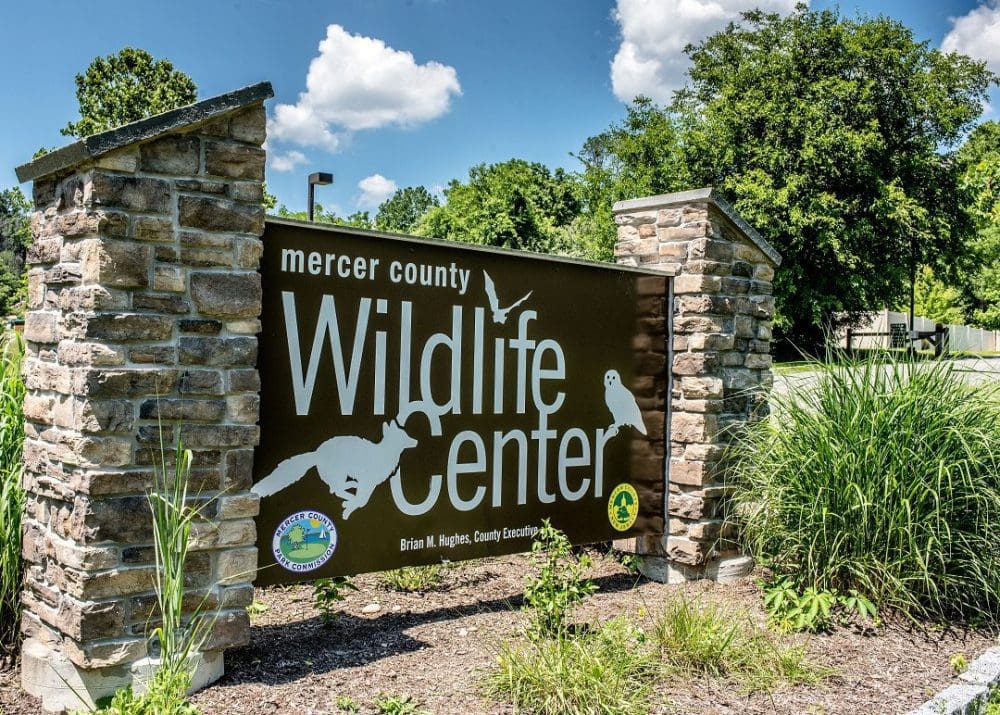In 1983, Mercer County naturalist Joe Schmeltz began caring for an injured female mallard duck in a basement of the county jail in Trenton, New Jersey. At that time no one could have imagined that this simple act of human kindness could evolve into what is now The Mercer County Wildlife Center; a 6,000-square-foot state-of-the-art wildlife rescue facility that includes an Outdoor Education Environment.
Born to Be Wild
In the beginning, Schmeltz had prisoner volunteers assist with the animal care as patients increased. In 1989 the animal rescue activities were relocated to a farmhouse owned by the county along the Delaware & Raritan canal on Route 29. As young animals and other wounded wildlife continued to escalate Schmeltz had two jobs – naturalist and Director of the rescue. The farmhouse began to deteriorate and a decision was made to move the wildlife to on-site trailers for care. As the surrounding human population grew and expanded into new areas more animals were coming in for urgent care.
In 2009 the Mercer County Wildlife Center (MCWC), moved into the present building which has; a surgical suite, a triage room, an ICU area, digital x-ray machine, mammal nursery area and isolation areas and avian isolation and nursery areas as well. The MCWC is a facility of the Mercer County Park Commission. Brian Hughes is the County Executive and Aaron Watson is the Executive Director of the Park Commission. It is operated with the assistance of the Wildlife Center Friends, a 501© non-profit working to support the MCWC through fundraising and education.
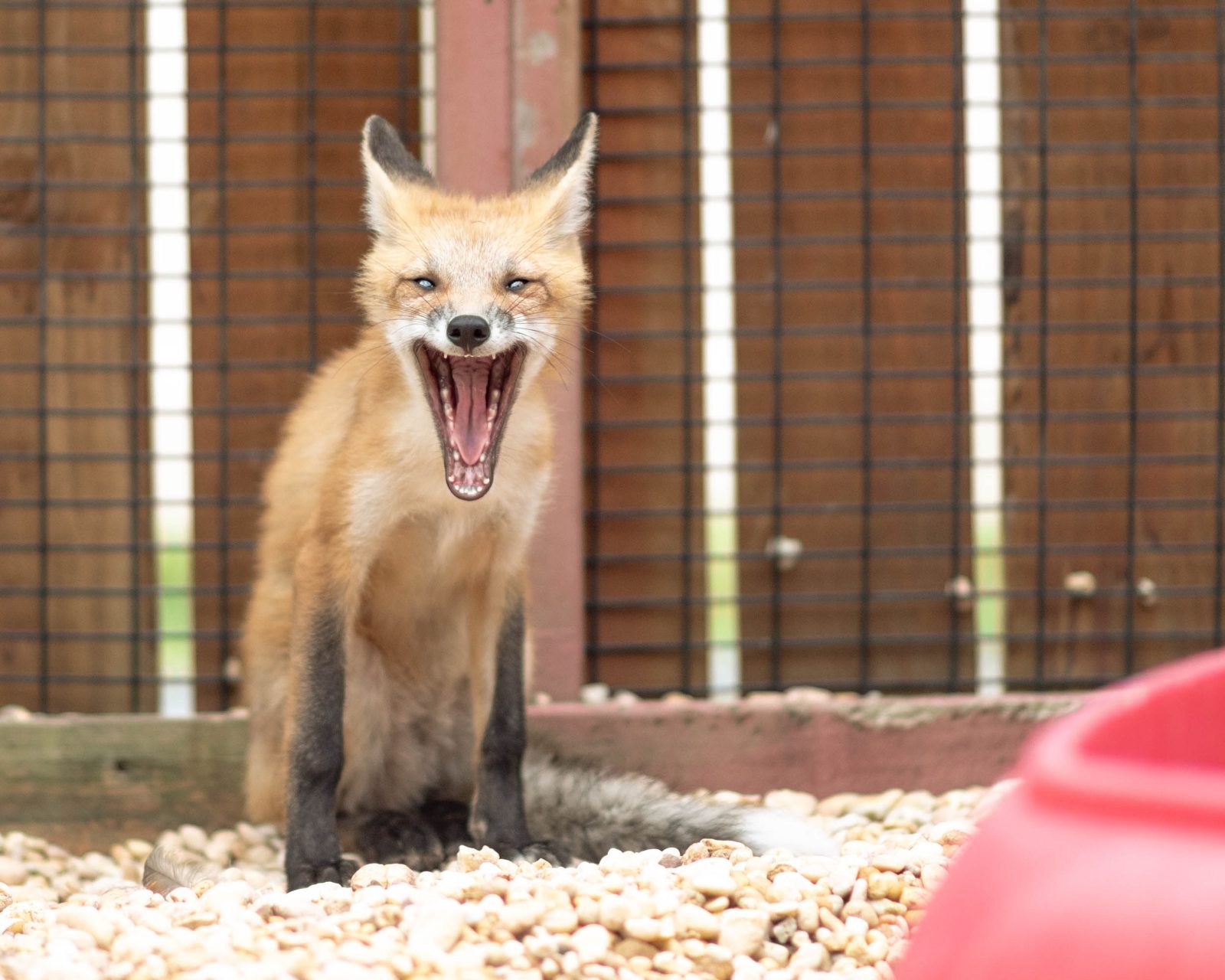
A Fox | photography by Kimberly Dawes
Numbers Don’t Lie
The MCWC is state and federally licensed to treat injured, ill and displaced wildlife. The center’s purpose is to provide temporary refuge before releasing back into the wild. The 2021 statistics from the MCWC illustrate the dedication of the staff to the care of these animals:
- New patients: – 2,843
- Calls: 18,000
- Different Species: 135
- Release Rate: 61%
Statistics are just numbers without context. Consider the above impressive statistics through the lens of covid and the fact that for almost two years volunteers were not able to assist staff due to pandemic restrictions. The MCWC has four full-time employees and six seasonal employees. Animals must be fed, cages cleaned and medical needs attended to 365 days a year— no breaks for covid or holidays. It also needs to be pointed out that a 61% release rate exceeds the national average of 50.2 percent. Knowing all this, it’s clear that MCWC is one of the premier rehabilitation facilities in the state of New Jersey.
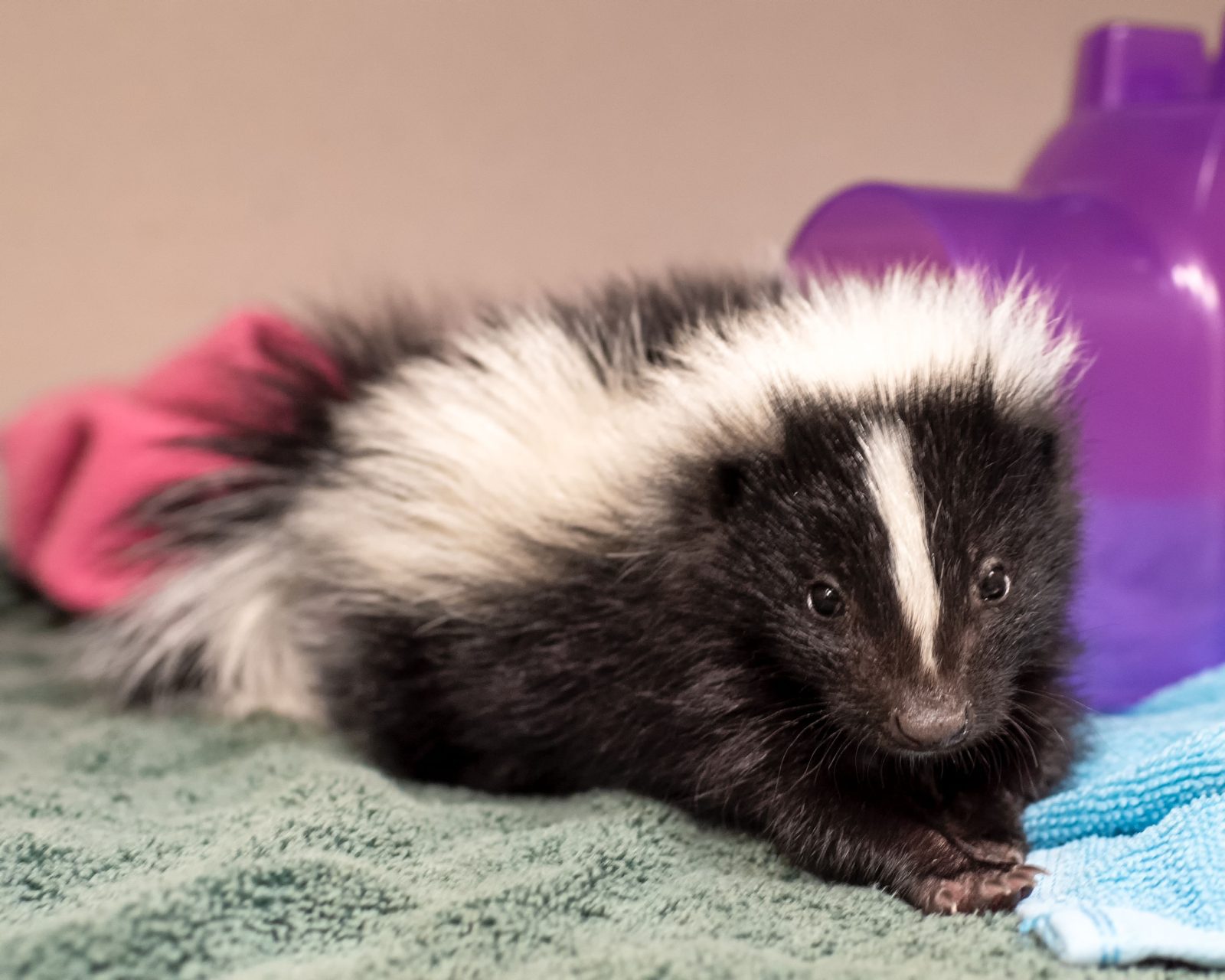
Skunk | photography by Kimberly Dawes
Why Do We Need a Wildlife Rescue Center?
New Jersey is the eleventh most densely populated state in the union. Taking into account our geographic size, and population concentration, it’s not hard to see that the territory once inhabited by native wildlife is being squeezed out every time someone pops up another McMansion here. We have an obligation to the wildlife we displaced to show a certain amount of care. This is most apparent in the Spring when the young are born. Of the nearly 3,000 animals per year the center cares for – almost 2,000 come in during Spring/Summer.
Leave Those Kids Alone
The majority of the 18,000 calls received are best handled by speaking to the Wildlife Rehabilitation Specialist. It is ALWAYS necessary to call before you bring an animal in or intervene. We never want to unnecessarily remove an animal from its mother or its home. The best advice is to NOT FEED any wildlife you find in distress. Find a warm, dark place that’s quiet where it can be safe. Do not handle. The center is a very busy place so if your call goes to voicemail-don’t worry. All calls are returned. Patients are accepted 10:00 a.m. to 4:00 p.m. Sunday through Saturday WITH APPOINTMENTS. The primary thing to keep in mind is that the welfare of the animals is the prime directive here.
Leadership is the Key
Diane Nickerson has been the Director of the MCWC since 1994. Diane’s bio sums up her dedication clearly; “I had a BA in Marketing and Management. I was working for an insurance company. I found two baby squirrels and quit my job and started on a completely new path.” Nickerson began volunteering at a wildlife rescue in Pennsylvania and went on to do an Environmental Education Internship at Peace Valley Nature Center. She convinced the rescue center to let her start an education program, which Nickerson ran. In 1994 she began as the Director of MCWC as the only employee with six inmate assistants. Under her stewardship, the MCWC has not only grown and flourished but has become a leader in the wildlife rehabilitation community.
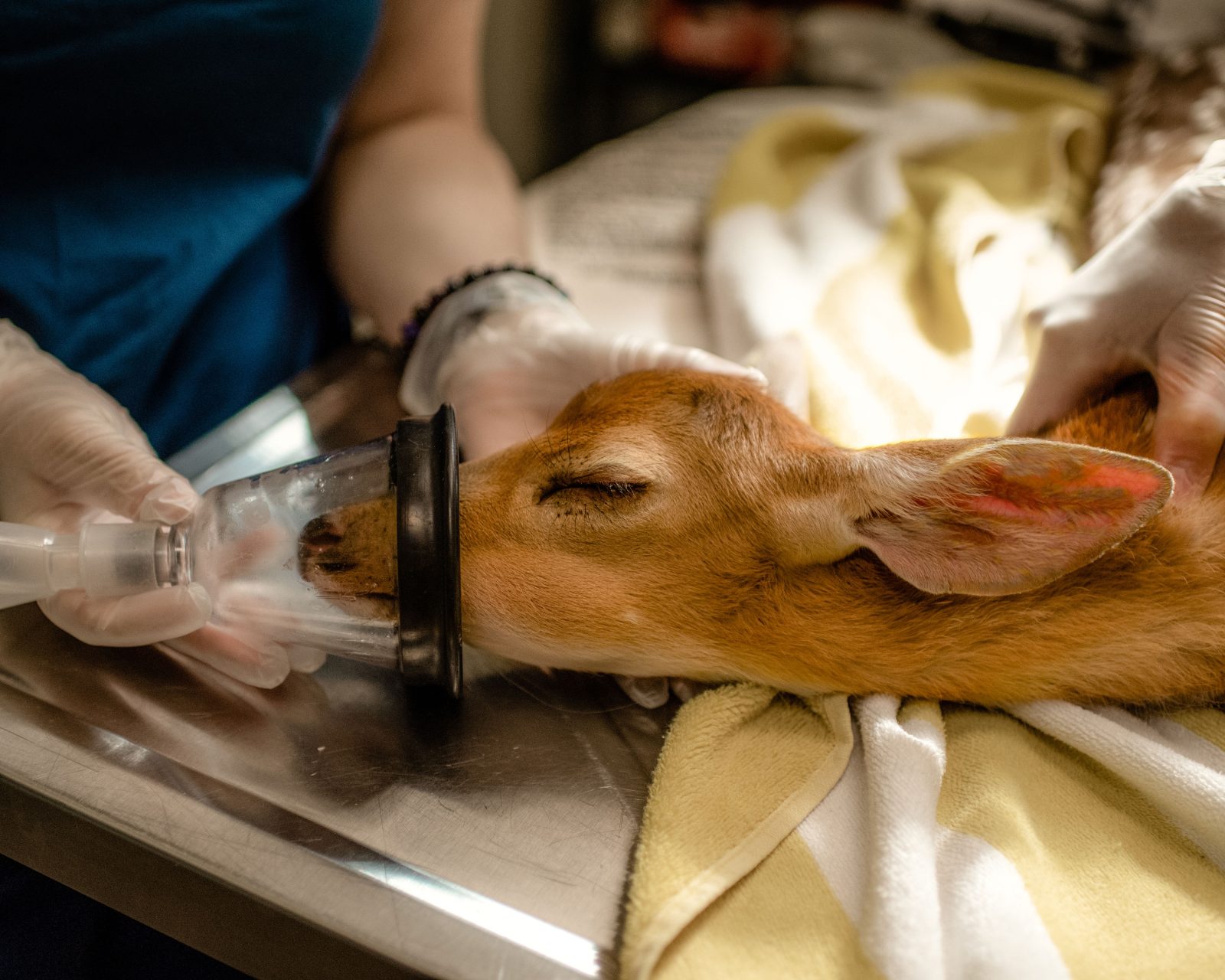
Fawn in Treatment | Photography by Kimberly Dawes
Education is Critical
The care of wildlife is a fairly new discipline. The best source of information and education is the National Wildlife Rehabilitator Association (NWRA), of which Nickerson is an active member. This professional organization is only forty years old. There are a handful of schools that offer coursework and some state organizations have conferences. Networking is a key benefit of the NWRA. The sense of camaraderie and “we’re all in this together’ seems to be a common note among the individuals in this evolving field.
The center’s first veterinarian, in 1983, was Dr. Peter Batts. Currently, there are four volunteer veterinarians and the doctors use the center for training veterinary students as well. Rowan University is going to be offering a degree soon in veterinary sciences.
Who Does This?
Kim Dawes oversees the volunteer program at the MCWC. She began as a volunteer in 2016 and in 2019 took over as Volunteer Coordinator. At its peak, the center had over 150 active volunteers. However, 2020 was the year everything changed; the pandemic shut those volunteers out and forced two teams of staffers to work full time in alternating 3-4 day a week shifts as restrictions in New Jersey tightened. It was not easy, but there is nothing like being thrown into the trenches to teach you, not only a crash course in wildlife care but just how strong and determined this small staff is.
The center now has 52 active volunteers and is actively working to increase that number. First-year volunteers are given training and orientation. For the initial season, volunteers should not anticipate handling or feeding any wildlife. New volunteers perform critical tasks to keep the center operational so the trained staff can do the more skilled work of caring for the patients. Chores include laundry, preparing meals and cleaning cages. If you think this isn’t rewarding- this probably isn’t the place for you. I do a four-hour shift every week and it is one of the most exhausting and exhilarating volunteer experiences I have ever had. To learn more about volunteering at the center or all the other ways to become involved with the MCWC visit the Wildlife Center Friends page. There’s a way for everyone to contribute ranging from time to money or supplies.
Take a Walk on the Wild Side
You may be sensing it takes a certain kind of person to do this, and you would be right. Jack Dreger is a Wildlife Rehabilitation Technician that started at the center as an intern. The MCWC offers an outstanding program for college students interested in exploring their love of wildlife as a future career. I’ve met students here already talking about future careers in zoos, or integrating the love of wildlife into disciplines with an ecological focus. It’s a twelve-week commitment and a great hands-on way to get experience in this newer discipline.
Dreger was a success story from this program. A natural to work with wildlife, coming from his childhood love of insects, dinosaurs and nature. Dreger felt his life course change last summer when he had the responsibility to feed and care for fifteen screech owl nestlings. He had to weigh them daily and feed these birds four times each day. He is most proud of the fact that fourteen of the original fifteen owlets were later released into the wild; and the one that didn’t make it had a pre-existing condition.
Animal Tales
Dreger is the one who first told me the story of the great-horned owl surrogate at the center. She came to MCWC in the late 90s and has lived here almost 30 years. In her time before she passed earlier this summer, she raised the fledglings and nestlings of other owls brought to the center every season. Preparing extra meals for her was always a treat in the kitchen.
The people that work at the MCWC take their jobs very seriously. You have to when you work at a place that’s open 365 days a year and where life, and death, really do sometimes hang in the balance. There are lots of regulations the center must adhere to and anytime an endangered species comes into the center it must be reported to the NJ Division of Fish & Wildlife, Endangered and Non-Game Species Program. They aren’t involved in actual care, but they do dictate release location on these animals. Nickerson had a story about taking in a nest of young birds so small the actual exact species couldn’t yet be determined. They “looked” like a red-bellied woodpecker so were treated accordingly. As they grew it became apparent they were endangered red-headed woodpeckers and the state had to be notified.
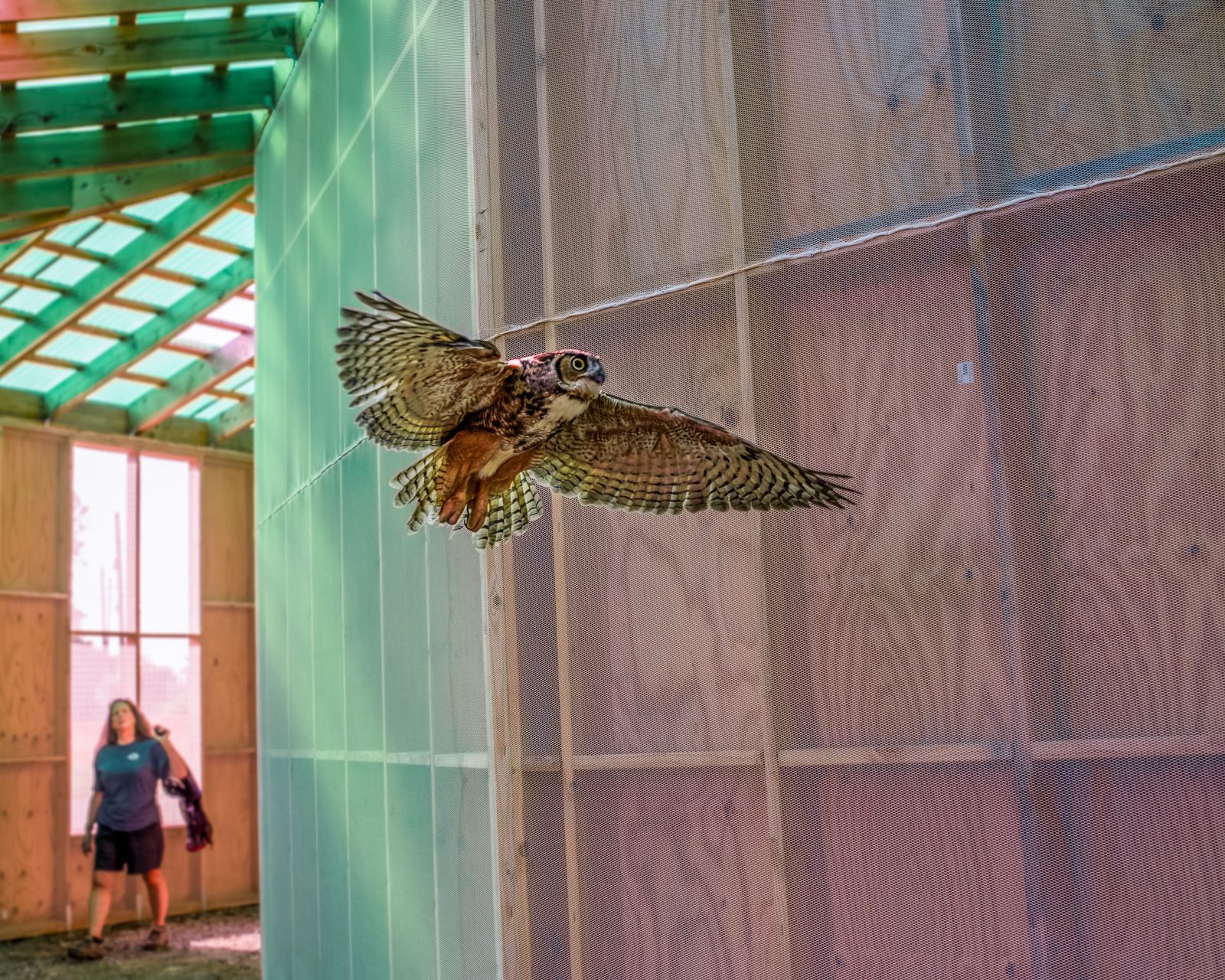
Owl in Flight Training | photography by Kimberly Dawes
Wild, Wild Life
Another interesting story I was told was of the infant mammal that was dropped off at a local dog shelter, assumed to be a dog. The shelter later called MCWC because that “pup” soon became a fox kit. It is illegal in all but two states (North & South Dakota) for humans to take wildlife out of the wild and make pets. That makes the story Nickerson told me about her most unusual experience that much more insane. Apparently, someone illegally had a Coatimundi as an illegal pet and dumped it into the wild; Animal Control brought it to the MCWC. It was placed at The Academy of Natural Sciences in Philadelphia as an educational animal and lived a long life.
Wild Is the Operative Word
If you’ve read this far, then hopefully you’re getting a sense of the center and of the people who staff it. The rewards here are not huge monetarily, but they are immense in the sense of helping our fellow planet inhabitants. Dawes told me that it’s all worth it when you experience releasing an animal back into the wild. Dreger said that his hands-on connection at the center motivated him to alter direction from changing the world through slower ecologically focused means to a more direct hands-on approach of doing something with more immediate impact.
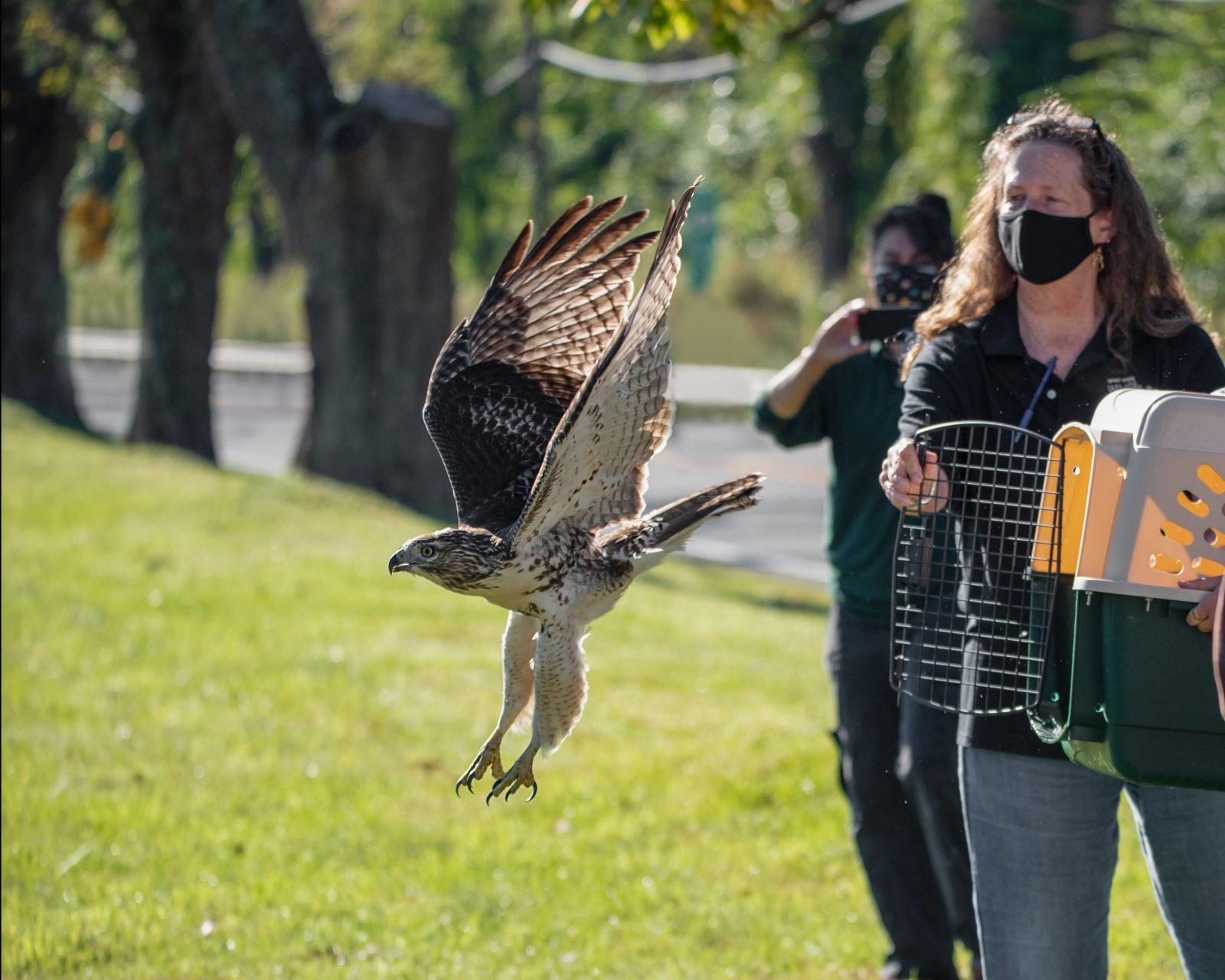
A Release Into the Wild | photography by Kimberly Dawes
What’s Next for the Mercer County Wildlife Center?
Nickerson’s goal is to educate people enough on co-existence that the center’s work becomes unnecessary. In keeping with her objective of education, her future dreams include putting another building over the current Outdoor Education Environment (OEE) which would have a lab to educate veterinary students and offer classes. The OEE currently houses animals who were treated here but are not able to be released back into the wild for medical reasons. The area is open to the public from Wednesday through Sunday 10 a.m. to 4 p.m. If you have never really heard a bald eagle scream – I highly recommend a visit.
Working at the MCWC is hard work, and it’s constant. infant animals need to be fed so often sometimes you finish one row of racks and it’s time to start all over again without a break. Raccoon poop is nasty to clean; turtle water smells pretty rank after a while. Yet every day these dedicated staff and volunteers show up and do the work of saving just one more squirrel or opossum. It’s not glamorous or even acknowledged by the general population. Nickerson told me the best part of her job was the feeling “she is making a difference.” Treating nearly 3,000 injured animals annually; educating over 20,000 school children each year with programs since its inception; yes, the Mercer County Wildlife Center is most definitely making a difference for the better.
About the Author/s
Sue graduated from Rutgers University with a B.A. in English back when you could still get a degree for reading great literature. She spent nearly 40 years working in the Sales & Marketing field with companies ranging from non-profits to small businesses to Fortune 100 Corporations. Most recently retired after nearly 20 years with S & P Global, she is now free to pursue her true passions for hiking, writing and photography. Sue was born and raised in New York State. As a New Jersey transplant, her passion for the special blend of culture and nature that is uniquely Jersey is what Sue loves to share with the world. She has one grown son that she is insanely proud of. Her husband of many decades is an amazing partner both in life and hiking. When not out exploring, Sue is most likely at home reading a novel with her dog.
